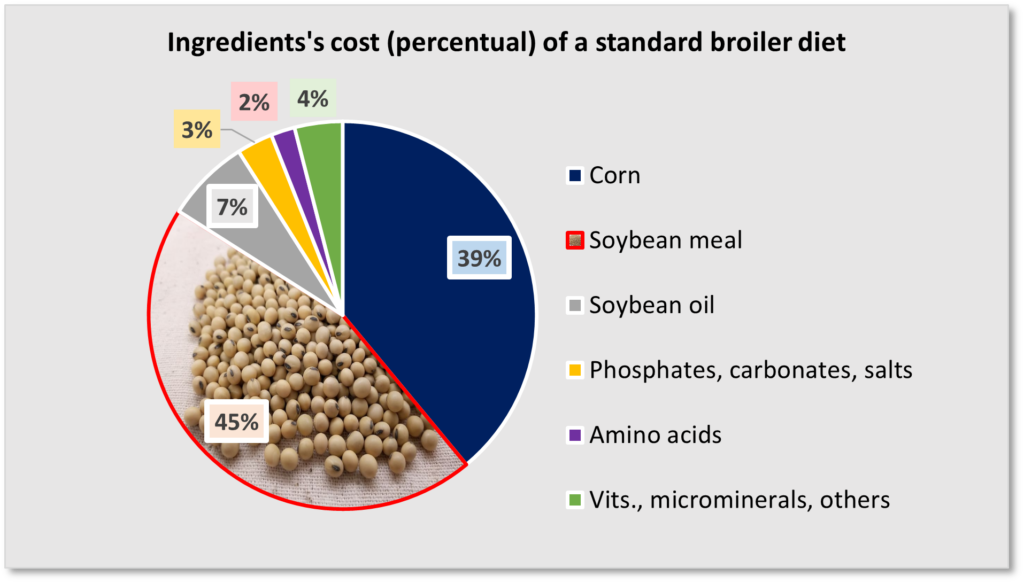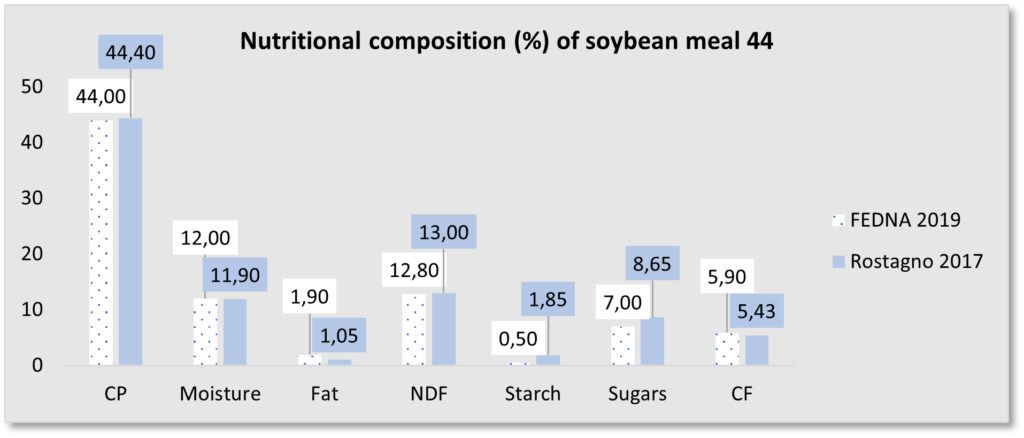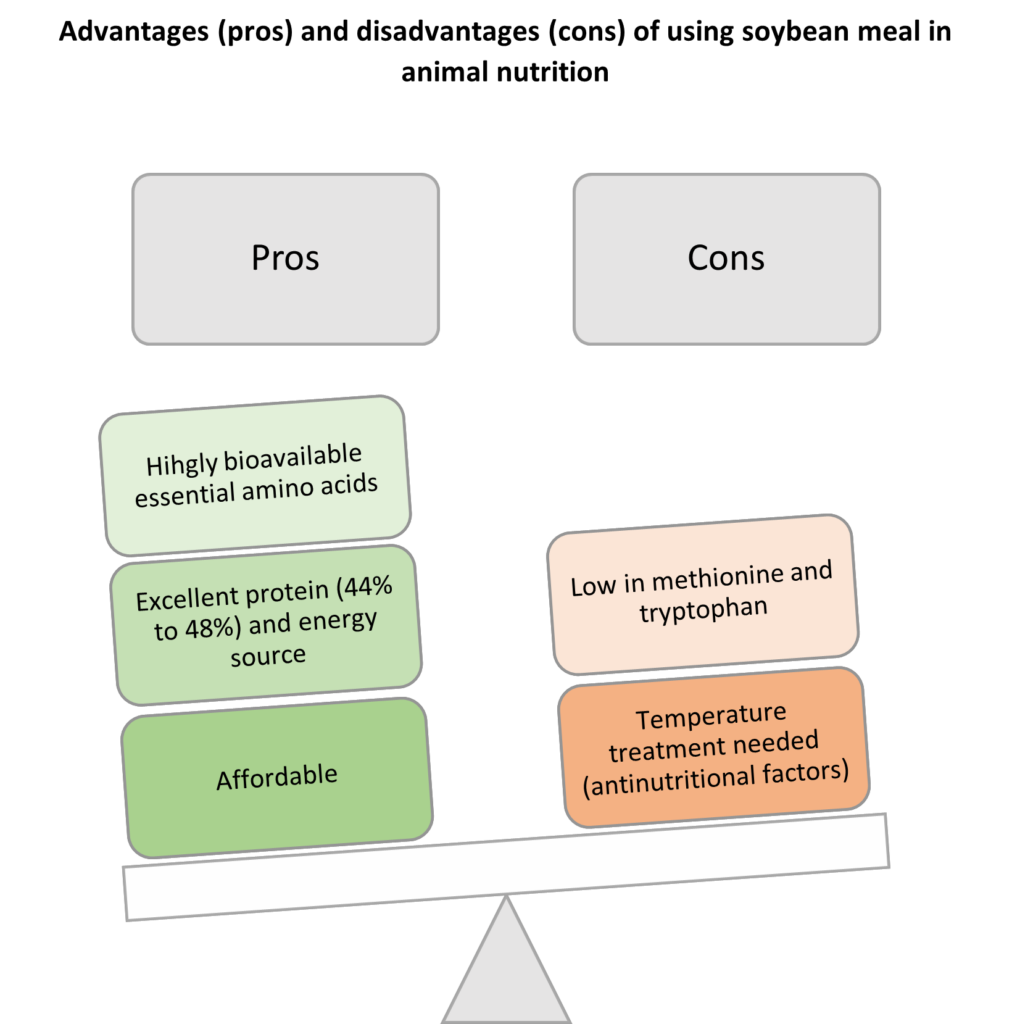Soybean meal is the protein source of choice for poultry diets because of its high crude protein (CP) content and amino acid composition. Besides, this protein source is relatively affordable compared to other ingredients of animal origin.
It is usually the highest expense in raw materials in a feed mill, which makes the evaluation of its quality much more important in order to take advantage of its properties. Soybean meal quality is tightly related to protein values rather than energy.

Composition
CP in soybean meal is high, between 44% and 48%. It comes from the soya bean, which contains around 36% CP, that is de-husked and undergoes a temperature treatment and an extraction with solvents to separate the oil.

Soybean meal’s nutrient profile should be analyzed before diet formulation to establish the nutrients it supplies and adjust the diet accordingly. Chiefly, the following areas should be considered:
- Amino acid profile
- Protein and amino acid digestibility
- Sugar and energy content
Amino acid profile: It is usually calculated using the CP content with the formulas suggested by FEDNA (2019) and Rostagno (2017). Despite amino acid profiles may vary slightly in these two sources, they can help us obtain approximate values.
| Lys | Met | Met+Cys | Tre | Trp | Ile | Val | Arg | |
| FEDNA | 6.08 | 1.35 | 2.83 | 3.91 | 1.30 | 4.45 | 4.70 | 7.22 |
| Rostagno | 6.17 | 1.34 | 2.81 | 3.92 | 1.41 | 4.69 | 4.89 | 7.38 |
Amino acid profile varies depending on soya’s origin, too. For example, soya from Brazil contains less lysin (Lys), methionine (Met) and threonine (Thr) than the Argentinian and US varieties.
Protein digestibility: Temperature and de-fattening processes to obtain soybean meal inactivate thermolabile antinutritional factors that are present in soya’s beans at considerable amounts. This helps to improve nutrient digestibility, particularly protein digestion, since trypsin inhibitors are deactivated (trypsin is the enzyme in charge of digesting protein). Other thermolabile antinutritional factors in soya are ureases and lectins that irritate the gut mucosa and decrease nutrient absorption.
Sugar and energy content: Despite it is the least important factor among the three, energy content should be considered for its impact on the final balance of the formula because feed usually contains this ingredient in high amounts. Usually, this ingredient contains 35% to 40% carbohydrates, but most of them are non-starch polysaccharides (NSP) that monogastric animals cannot use as an energy source.
Soybean meal contains high-quality fat, generally with a high content of linoleic acid. For this reason, its inclusion in feed for laying hens has been related with an increase in egg size.
Quality control
It is essential to supervise the processing conditions, including homogeneity conditions, particle size, temperature and pressure, processing duration and humidity, in order to obtain high-quality products. Avoid underprocessed soybean meal, as it will have a too high amount of trypsin inhibitors and ureases; and overprocessed soybean meal, as Maillard reactions with lead to the presence of toxic compounds that reduce amino acid digestibility.
To test soybean processing quality, analyze urease and trypsin inhibitor activity, whichshould be below 0.20 and 3.5 mg/g, respectively; and reactive lysin activity should be above 85%. KOH solubility above 72% also indicates protein solubility is high and decreases when overprocessing.
Inclusion limits in poultry feeds
Soybean meal limitations exist for broilers over 18 days of age, when inclusion levels should be below 40% according to FEDNA (2019). The recommended value is 35% (Rostagno, 2019). For layers, the recommended inclusion level is 30% (Rostagno, 2019).

Bibliography
FEDNA 2019. Blas, C. de, P. Carcía-Rebollar, M. Gorrachategui, and G.G. Mateos. Tablas FEDNA de composición y valor nutritivo de alimentos para la fabricación de piensos compuestos, FEDNA (Fundación Española Para El Desarrollo de La Nutrición Animal). 4th edition, Madrid http://www.fundacionfedna.org/ingredientes-para-piensos
ROSTAGNO 2017. Rostagno, H.S. et al. 2017. Tablas Brasileñas Para Aves y Cerdos. Composición de Alimentos y Requerimientos Nutricionales. 4th edition. Horacio Santiago Rostagno. Universidad Federal de Viçosa, Departamento de Zootecnia.
Kalinowski Echegaray, Juan. 2005. “La Soja Integral En La Alimentación Avícola.”: 1–12. http://www.wpsa-aeca.es/aeca_imgs_docs/05_06_51_SojaIntegral.pdf